Before we go any further, a correction. In the last issue of the newsletter our co-organiser Jeff embarrassingly misidentified the two latest trees on the big green space off Sunray Avenue, opposite the junction with Casino Avenue. He claimed they were rowans (Sorbus aucuparia), also known as mountain ash, but in fact they turned out to be edible apples (Malus domestica). In his defence (admittedly a pretty weak defence) it is winter, so there are no leaves, flowers or fruit to help us and no ID tags on the trees. Also the buds of both genera, Sorbus and Malus, are similar, and they're from the same Rose family (Rosaceae). But a more experienced observer would have recognised them at a glance. For a start, a cultivated standard rowan is much narrower and more upright than an apple tree. Here’s a typically bushy apple at the orchard in Dulwich Park:

Retro apple flavours
The two new apple trees on the Sunray green - properly identified this time by our council tree officer, Ernst Erasmus - will both be very familiar to you. One’s an old-fashioned Bramley cooking apple, a favourite for pies since the late 19th century, and the other is a bright green Golden Delicious eating (or dessert) apple, popular since the seventies when the UK joined the Common Market (now the EU) and they started arriving from France.
Unusually, apples and pears grown for fruit are the highlights of the latest phase of planting in this 2022/23 season, which runs until the end of March. Up to now the many apples, pears, plums and cherries in Herne Hill have been selected principally for their spring blossom and their autumn colours, and their fruit is usually too small, too high up and too sour to be worth picking. Crab apples (Malus sylvestris) are very colourful, of course, but when they drop they make a slippery mess on the pavement.
It makes much more sense to plant fruit trees on grass, where they can be trained and maintained to produce an abundant crop within easy reach. The green spaces in and around housing estates are ideal, providing they’re not already enjoyed for children’s play or other activities. The green at Sunray has hosted a collection of orchard trees for some time, and with the arrival of the new Bramley and Golden Delicious there are now 10 edible fruit or nut trees growing there: not only apples, but also cherries, hazels, pears, a quince and medlar.
The three older apple trees alongside the perimeter road between 49 and 71 Sunray are looking decidedly tangled and aren't producing any fruit, so Paul, our co-organiser, and Alex Kader, one of our volunteers who lives nearby, will be trimming and reshaping them soon, with the council’s approval. Contact us if you’d like to join them and learn a little about the method.
Fruit trees at Hillcrest
By contrast, the grounds of the Hillcrest estate at the other end of Sunray Avenue, approaching Denmark Hill, have remained pretty empty until now, and despite the loss of some big trees in recent years only two smallish ones have been planted. But that’s all changing. Thanks to the efforts of resident Sandra Joseph, Hillcrest now has its own brand new orchard for local people to enjoy and look after. Planted in late January, it’s located on a previously bare sloping lawn between two blocks of flats, nos. 16-30 and 31-45.
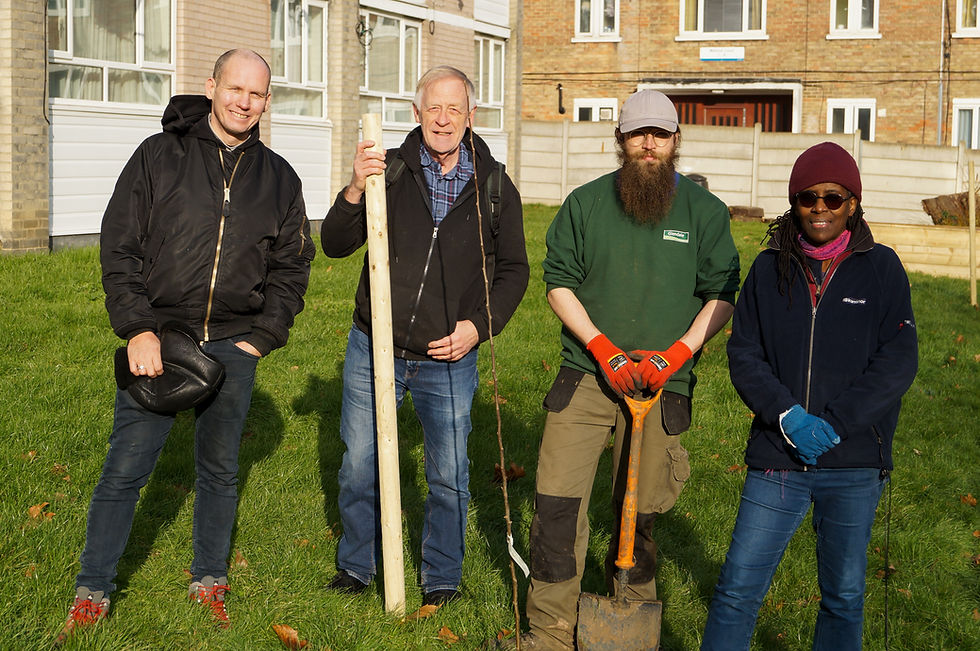
There are eight trees altogether, four apples and four pears, funded by a successful Cleaner Greener Safer award from the council and sourced from Keepers, a specialist nursery in Kent. Sandra has also set up some herb and vegetable beds in the same area and has had a 1,000-litre water butt installed just around the corner. It’s hoped that local volunteers will do much of the regular care and maintenance needed to bring the trees to maturity: pruning, mulching and watering.
The new saplings are known as first year maidens, one year old and basically long, flexible twigs roughly 1.5 metres tall. They’ll never reach the height of a standard apple or pear tree but they should start producing fruit much earlier, in as little as two years.
Like all apple and pear cultivars (varieties produced by selective breeding) the Hillcrest trees were propagated by grafting: cutting a small branch, known as a scion, from the fruit tree that you want to reproduce and splicing it into the roots of another. These commercially produced rootstocks, which go by names like MM106, are designed to restrict the size of new trees, strengthen their resistance to disease and insect attack and ensure they’re hardy in all weathers.
You can in theory grow apples from pips sown in the ground. They're known as pippins (as in Cox’s Orange Pippin, a 200-year-old favourite). But a genetic quirk means they won’t grow true to type. “Plant the pips of a hundred apples from the same tree and the new generation of trees can differ, often dramatically, from their parents and from each other,” wrote Roger Deakin in Wildwood: A Journey Through Trees. In fact you could put three seeds from the same apple core in a patch of soil and three completely different trees with unpredictable-tasting fruit would be the result.
Fruit tree varieties
The varieties chosen for Hillcrest, with guidance from Tree Watch co-organiser Paul, are all good to eat. These are the apples:
Two Sunsets (Malus domestica 'Sunset'), which the Royal Horticultural Society (RHS) describes as a compact dessert apple with pale pink flowers and fruit that can be used from October to December.
Two Adams Pearmains (Malus domestica 'Adams's Pearmain'), a late dessert apple, according to the RHS, bearing yellow, conical fruit with red stripes. The trees produce a good crop of aromatic, nutty-flavoured apples in mid-autumn which can be stored until early spring.
And these are the pears:
Two Concordes (Pyrus communis 'Concorde'), a compact dessert pear with white flowers and green fruit.
One Williams (Pyrus communis 'Williams' Bon Chrétien'), a dessert pear with white flowers and yellow-green fruit and a good flavour that can be used from mid- to late September.
One Louise Bonne of Jersey (Pyrus communis 'Louise Bonne of Jersey'), a richly flavoured, buttery and juicy dessert pear, producing good, regular crops from October to November.
Fruit tree pollination
Great flavours aren’t enough, though, when you’re selecting apple and pear trees. The plump and round fruit buds that form in November will open as flowers in April and May, and the flowers will transform into fruit over the following five or six months - but only if they’re pollinated. In almost all cases the pollen has to come from a compatible tree nearby.
At Hillcrest the Sunset and Adams Pearmain apples are both in pollination group C, which means they can readily cross-pollinate. Among the pears (which are less fussy about their partners) Concorde, in group C, can cross-pollinate with Williams (B) and so can Louise Bonne of Jersey (A). Over at Sunray the Bramley is in group D, the same as its neighbour, the Golden Delicious. The pollen is carried from tree to tree by bees in 90% of cases, but other insects such as wasps, moths and butterflies also play a part.
Formative pruning
One of the earliest tasks at Hillcrest will be to prune the new trees. Apples and pears are normally pruned in February and then again in the autumn, while cherries, plums and other stone fruit have to wait until late July or August. For the first few years the aim is to produce a good shape. That means discouraging too many branches in the crown so that the light gets in and the fruit has space to grow, and encouraging branches to grow horizontally so that it hangs low. Branches should also be cut back where they cross over or rub against others.
Pruning for fruit
At this stage the focus is on growing and training branches, but later it will turn to maximising fruit production. To do this right you’ll need to know a little about where along the branch the apples or pears will actually grow. Otherwise you might accidentally snip off a twig or shoot that would have developed into a fruit.
Apple and pear cultivars fall into three groups, according to where the fruit grows: tip-bearing, spur-bearing or partial tip-bearing. Spur-bearers, like our Golden Delicious at Sunray, are the biggest group. They produce fruit buds on spurs, which are stubby side shoots coming off the branches. Tip-bearers have fruit buds at the ends of long shoots. And partial tip bearers, including the Bramley, have a bit of both.
Here’s a picture of the characteristic knobbly, wrinkled fruiting spurs on an older pear in the orchard at Dulwich Park, formed by repeated pruning of the same side shoot. You get the same rugged appearance on properly maintained spur-bearing apples.

And this is a photo of a tip-bearing apple at the park orchard. The fruit bud is downy, fat and rounded, while the small, dark scaly buds arranged alternately along the shoot are wood (or growth) buds, which will produce leaves but no flowers or fruit.
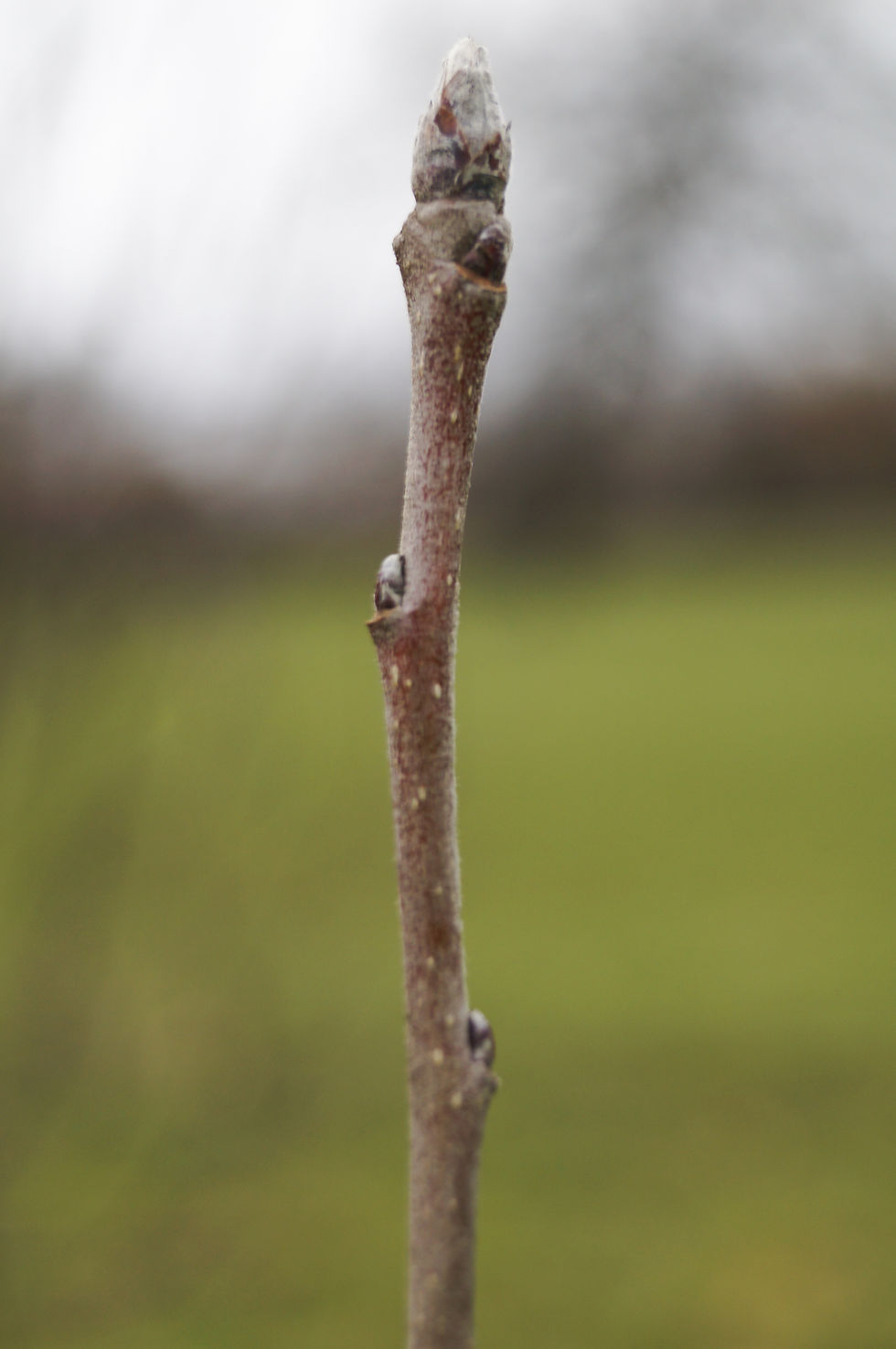
Other trees for Hillcrest in the pipeline
Besides the apples and pears, yet more trees will be arriving at Hillcrest before this season is over. The first to come should be three Heaven Scent magnolias (Magnolia ‘Heaven Scent’) earmarked for the grass alongside the concrete boundary wall near the new orchard.
Then two big replacement trees are planned for the grass verge in front of the garages where a pair of Northern red oaks have been lost. One’s likely to be a Zlatia beech (Fagus sylvatica 'Zlatia'), with leaves that unfurl yellow before turning light green. To fill the second empty spot we’re pressing for another big oak for its high environmental value.

In addition there’s a project underway to plant a mixed native hedge at Hillcrest on the grass strip in front of the sheds outside block 31-45. It will be made up of wildlife-friendy species like guelder rose (Viburnum opulus), common holly (Ilex aquifolium), common hawthorn (Crataegus monogyna) and wild privet (Ligustrum vulgare), planted by the council’s grounds maintenance team.
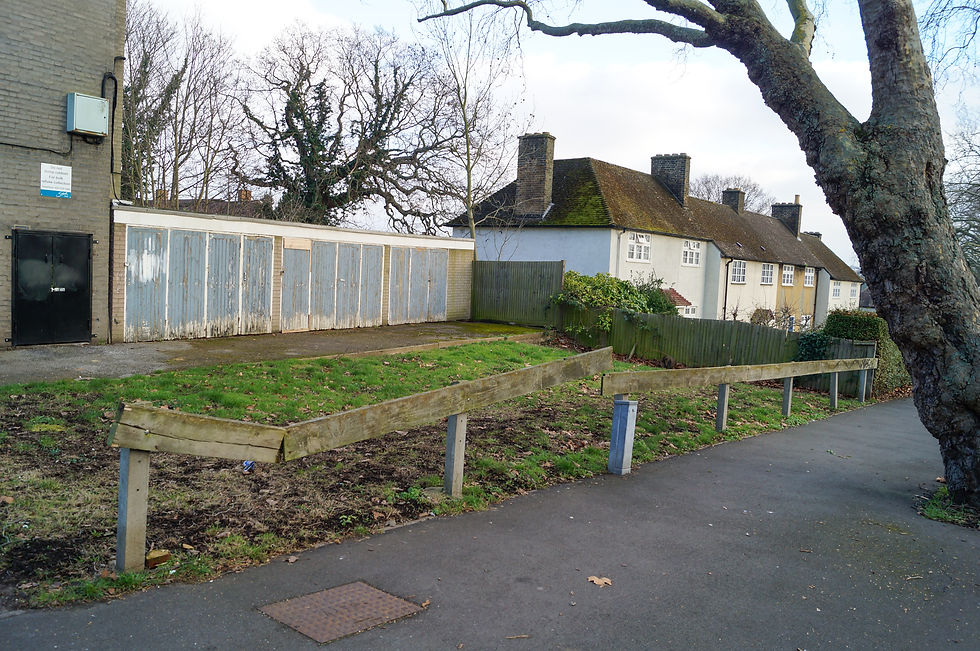
Street trees still being delivered
Elsewhere in Herne Hill two new street trees were planted in January:
A silver birch (Betula pendula) at 79/81 Beckwith Road and
An Amur maple (Acer ginnala) at the bottom of Frankfurt Road, alongside the back garden of 30B Elmwood Road. Its three-lobed leaves turn deep crimson as early as September.
The running total of new trees planted since the season began stood at 61 by the end of January, with another 21 still awaited, including two more elms for the grounds of the Denesmead and Pynnersmead, near the foot of Herne Hill. Each will be a Dutch Elm disease-resistant hybrid called New Horizon (Ulmus 'New Horizon'). Their planting locations are shown with blue dots on this map:
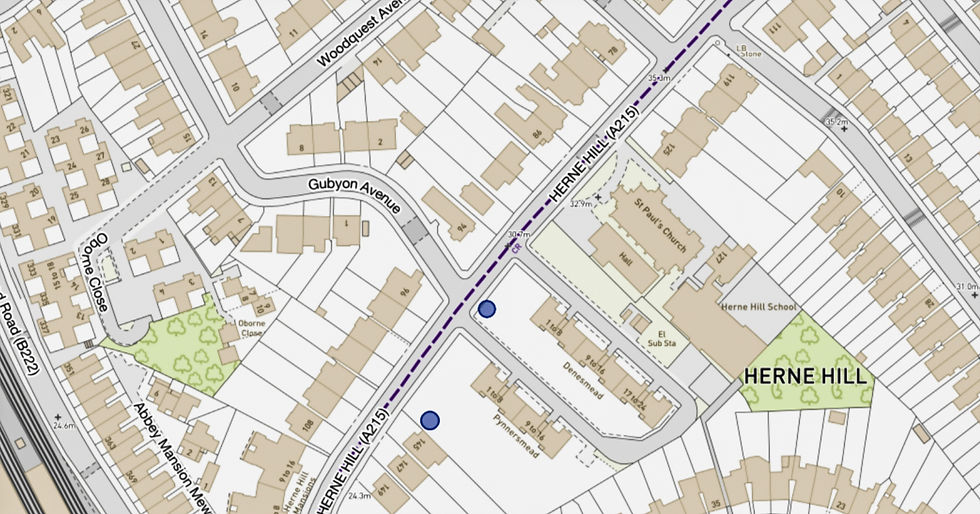
All five magnolias that were held back from Casino Avenue in November (when the tree pits were blocked by underground services) have now been allocated new homes. Three are going to Hillcrest, as we mentioned above, and one to the top of Hollingbourne Road, at the side of the Herne Hilll School kindergarten. The fifth orphaned magnolia is headed to this strip of lawn outside house no. 32 on the Delawyk estate, where it’s not always easy to find suitable species and acceptable locations.

Finally, we’re scheduled to see the last batch of fruit trees this season planted soon in the little grassy square outside the Casino Avenue flats at nos. 36 to 82. Two of them will be plums but the third hasn’t yet been specified. Local residents will know that this square has sometimes been used for fly-tipping, so if you see any rubbish there, like this mattress spotted a couple of weeks ago, do report it to the council.
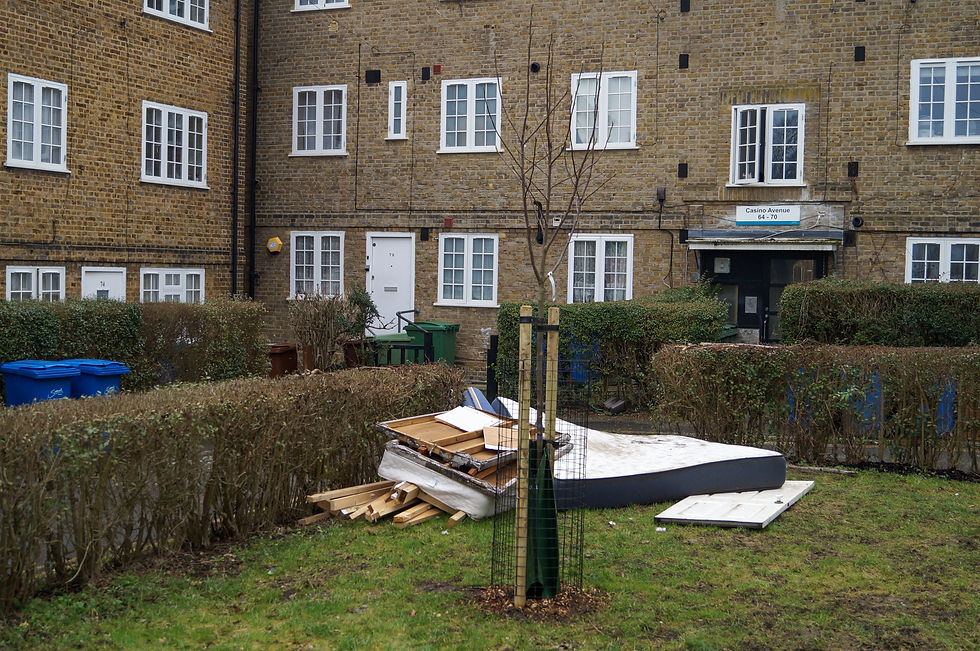
Comments